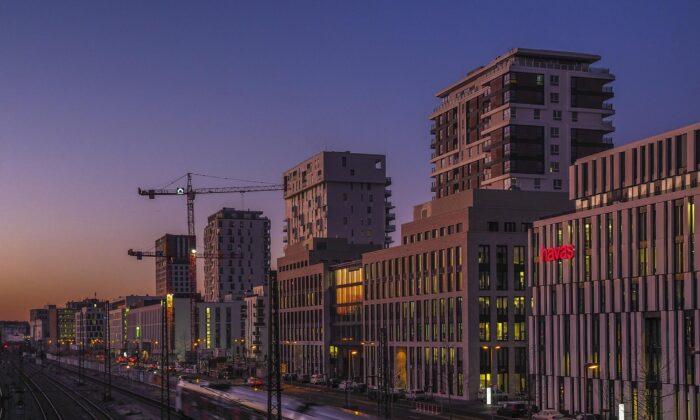The U.S. commercial real estate market slowed down for the first time in 13 months, as rising interest rates and inflation caused worries throughout the industry.
Commercial property sales for April fell 16 percent from the same month in 2021 to $39.4 billion, according to an MSCI Real Assets report last month.
In contrast, total commercial property sales in March were 57 percent higher than the same month the year before.
The commercial sector was particularly hard hit in the first year of the pandemic, after thousands of hotels, entertainment venues, retailers, and offices were shut down throughout the country, with millions of Americans laid off or sent home to work remotely.
The market saw a slow rebound in December 2020, as investors took advantage of vacant commercial properties amid low interest rates in anticipation of an eventual market recovery.
Commercial investors showed particular interest in multi-family housing and in industrial properties, which still showed profitability throughout the continued lockdowns, compared with the once desirable office properties that stood vacant.
Investments in industrials and apartments kept the market alive through April 2022 after the Federal Reserve decided to start raising interest rates in March in an effort to fight growing inflation, following two years of cheap stimulus cash which drove potential buyers out of the market and caused a major drop in sales.
“The other big shock is recessionary pressures, both in costs and in interest rates,” she concluded.
The Fed has so far increased interest rates by 75 basis points this year, with an additional 50-point hike expected next week.
The yield on 10-year Treasury notes, the benchmark for commercial mortgages, has doubled since the central bank policy shift.
In the first two months of 2022, the range for the 10-year Treasury yield was 23.7 bps and 28.1 bps, respectively, before jumping to 78.5 bps in March, 54.0 bps in April, and 37.4 bps in May.
Rising interest rates are now deterring many banks from lending to buyers over investments that appear potentially to be too risky, with investors who relied on easy credit quickly dropping out of the property market.
While most investors have been moving ahead with planned purchases, some are attempting to walk away from deals still in contract, while others are more cautious about acquiring more properties for now.
Some prospective buyers in the small industrial and retail sectors who were rushing to purchase properties back in early spring are now pulling back to avoid higher borrowing rates.
Meanwhile, sales of retail properties continued to see gains, due to positive consumer spending through April.
However, Philip Nicozisis, Chairman of Nico Properties Group, LLC., believes it “usually takes some time for the rising interest rate environment to affect the investment market, which is what happened in the past, and I think that’s going to happen again this time.”
The May RCA CPPI report said that retail properties increased 18.4 percent in April from a year ago.
Multi-family apartment sales also continue to rise, as higher mortgage rates push buyers out of the single-family home market, leading to stronger demand.
The data from the report said that industrial prices rose 26 percent from a year ago in April and apartment prices increased 23 percent, with both the industrial and apartment indexes rising 1.3 percent from March.
The report estimates that the price rise from March to April suggests around a 17 percent annualized rate of growth, which is “slower than the posted pace of yearly change for these indexes.”
However, even those sectors are beginning to feel pressure due to higher interest rates, as the threat of an economic slowdown or a recession toward the end of the year is leading to a pessimistic outlook.
Nicozisis remains positive noting, “industrial and small retail is still strong because, we still have real estate shortages from the pandemic and even housing is in short supply.”
He said that “capital markets and investment sales continue to be robust based on scarcity of product, and that ”there’s also been mergers with some with real estate investment trusts (or REITs) in addition to rising interest rates, which means that investors are accepting a new normal, meaning less returns.”
A rapid drop in commercial real estate investment due to rising interest rates will in the long term, ease purchasing prices, as higher rates shrink the number of willing buyers, forcing owners into making concessions to buyers if the market dries up.
This could open a window of opportunity for wealthier real-estate investors with extra capital searching for better bargains.
“I think investors and sellers are going to just say no, as there’s a little bit of a waiting period before prices come down,” said Nicozisis.
“There’s a bit of a shock with the interest rates rising so quickly, so prices are going to have to come down, but it’s going to take probably a year or so before that reality sets in with sellers,” he said, concluding that “people are just going to have a wait-and-see approach.”





